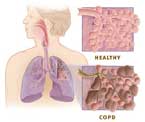The very first placebo-controlled, randomized study on the effectiveness of acupuncture for the treatment of chronic obstructive pulmonary disease (COPD) concludes “that acupuncture is a useful adjunctive therapy in reducing” breathlessness in patients with COPD. A decrease in shortness of breath in patients with COPD is directly proportional to increased survival rates indicating that acupuncture prevents mortality associated with COPD. The researchers note that acupuncture improved arterial blood gas, rib cage range of motion, respiratory function (including forced vital capacity) and respiratory muscle strength. The ability to increase exercise capabilities was also greatly increased by acupuncture treatment. Moreover, acupuncture improved the activities of daily living score. In addition, acupuncture significantly improved nutritional levels including BMI (body mass index) and pre-albumin levels, common major nutritional problems for patients with COPD.
 Acupuncture for COPDA placebo acupuncture group was compared with a real acupuncture group. The placebo group received simulated needling using a Park sham device. The device uses a blunt tipped needle that looks as if it is penetrating the skin but, in reality, telescopes back into the upper part of the needle handle. Both the sham needle and the real needles were 0.35mm X 70mm stainless steel acupuncture needles. The real acupuncture needles were inserted between 5mm to 25mm. Electroacupuncture was not used and manual rotation stimulation was performed at each needle for 3-5 minutes until the de qi sensation was achieved. Total treatment time was 50 minutes for each treatment. Acupuncture treatments were administered once per week for a total of 12 weeks. The acupuncture points chosen for the study were: LU1 (Zhongfu), LU9 (Taiyuan), LI18 (Futu), CV4 (Guanyuan), CV12 (Zhongwan), ST36 (Zusanli), KI3 (Taixi), GB12 (Wangu), UB13 (Feishu), UB20 (Pishu), UB23 (Shenshu). The researchers note, “We demonstrated clinically relevant improvements in DOE (dyspnea on exertion) (Borg scale), nutrition status (including BMI), airflow obstruction, exercise capacity, and health-related quality of life after 3 months of acupuncture treatment.”
Acupuncture for COPDA placebo acupuncture group was compared with a real acupuncture group. The placebo group received simulated needling using a Park sham device. The device uses a blunt tipped needle that looks as if it is penetrating the skin but, in reality, telescopes back into the upper part of the needle handle. Both the sham needle and the real needles were 0.35mm X 70mm stainless steel acupuncture needles. The real acupuncture needles were inserted between 5mm to 25mm. Electroacupuncture was not used and manual rotation stimulation was performed at each needle for 3-5 minutes until the de qi sensation was achieved. Total treatment time was 50 minutes for each treatment. Acupuncture treatments were administered once per week for a total of 12 weeks. The acupuncture points chosen for the study were: LU1 (Zhongfu), LU9 (Taiyuan), LI18 (Futu), CV4 (Guanyuan), CV12 (Zhongwan), ST36 (Zusanli), KI3 (Taixi), GB12 (Wangu), UB13 (Feishu), UB20 (Pishu), UB23 (Shenshu). The researchers note, “We demonstrated clinically relevant improvements in DOE (dyspnea on exertion) (Borg scale), nutrition status (including BMI), airflow obstruction, exercise capacity, and health-related quality of life after 3 months of acupuncture treatment.”
Points of Interest
Interestingly, the researchers did not use Dingchuan (M-BW-1). This modern ‘extra’ acupuncture point is specific for the treatment of dyspnea, wheezing and coughing. Dingchuan is also used for the treatment of urticaria and upper back pain.
The researchers chose LU1 (Middle Palace). Located on the lateral aspect of the chest in the first intercostal space, LU1 is the Front Mu point of the Lung and is the Meeting Point of the Lung and Spleen channels. The other Lung channel point used in the study was LU9 (Supreme Abyss). Located at the wrist joint in the depression between the radial artery and the tendon of the abductor pollicis longus, LU9 is the Yuan-Source point of the Lung channel. It is also an Earth point, a Shu-Stream point, and a Hui-Meeting point. LU1 helps the Stomach Qi descend, clears heat, regulates water passages and relieves coughing and wheezing by helping the Lung Qi to descend. LU9 tonifies the Lungs, transforms phlegm, regulates the vessels and relieves pain.
LI18 (Support the Prominence) is located on the lateral aspect of the neck, level with the tip of the Adam’s Apple and is between the heads of the SCM (sternocleidomastoid) muscle. LI18 is a Window of Sky point and relieves coughing, wheezing, dysphagia, throat pain and hypotension. CV4 (Gate of Origin) and CV12 (Middle Cavity) are the Front Mu points of the Small Intestines and Stomach respectively. These powerful points tonify Qi as does ST36 (Leg Three Miles). Additional points used in the study were used to benefit Lung function and to harmonize and strengthen the body.
Reference:
Suzuki M, Muro S, Ando Y, et al. A randomized, placebo-controlled trial of acupuncture in patients with chronic obstructive pulmonary disease (copd). The copd-acupuncture trial (cat). Acupuncture in patients with copd. Arch Intern Med. Published online May 14, 2012. doi:10.1001/archinternmed.2012.1233.

